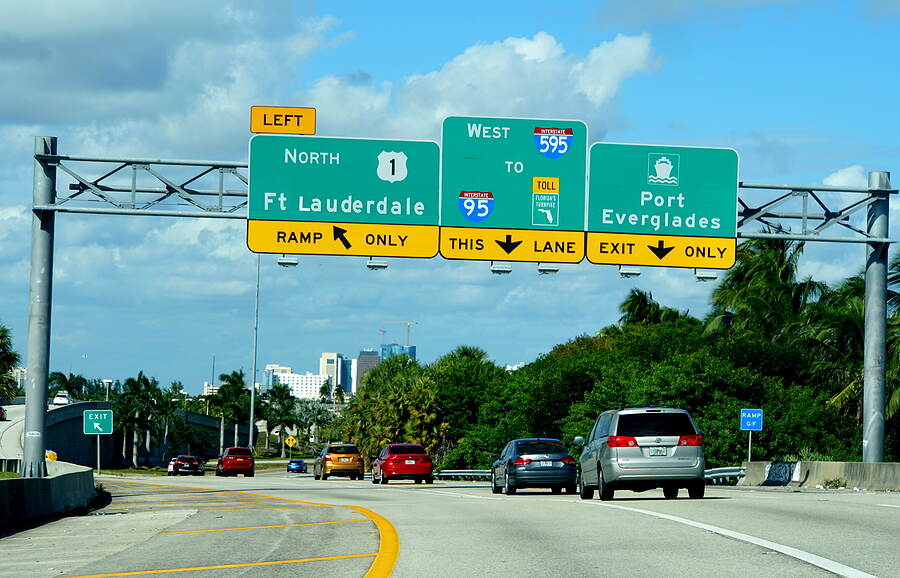
The two years of the pandemic have generally been good for traffic volumes that were far below average for most of the two years. As people begin to go back to offices, those numbers will undoubtedly continue to rise.
However, even with the significantly lower traffic volumes of the past two years, traffic accidents of all kinds and traffic fatalities have seen almost inconceivable increases.
Thus, for example, the first six months of 2021 saw more than 20,000 people killed in motor vehicle accidents in the United States
, an 18.4 percent increase over the same period for 2020. Further disheartening news for road safety is that the National Highway Traffic Safety Administration (NHTSA) also found that speeding and failing to use seatbelts increased from March 2020 to June 2021.
Individual states and cities also saw increases in total accidents and traffic fatalities over the years of the pandemic. For example, New York City traffic dropped by a full two-thirds in the peak of the business shutdowns. Currently, NYC neighborhoods are back to about 80 to 90 percent of pre-pandemic traffic volumes. Long Island’s roads saw a decrease of about 50 percent and are now back to nearly 85 percent of pre-pandemic levels.
Nonetheless, just as with the country as a whole, New York’s accidents have not seen a corresponding drop.
For a free legal consultation, call 516-451-7900
Overall Motor Vehicle Crash Stats
NHTSA projects more than 31,000 people died in motor vehicle accidents in the United States in the first three quarters of 2021 (the most recent estimate available), a 12 percent increase over the same period in 2020. According to the NHTSA, these numbers are the highest number of fatalities since 2006 and the highest percentage increase during the first nine months of the year since NHTSA began its Fatality Analysis Reporting System.
NHTSA noted that fatalities also increased in 38 of the 50 states, decreasing only in 10 states and the District of Columbia. Miles traveled continued to recover from the pandemic, showing an 11.7 percent increase over this period in 2020.
The year before the pandemic, the State of New York experienced 447,021 motor vehicle accidents, resulting in 881 deaths and 121,068 deaths. The next year, despite a huge pandemic-induced drop in traffic volumes and numbers of accidents, saw more than a ten percent increase in the number of traffic fatalities. While pedestrian deaths were down, fatalities involving bikes and motorcycles significantly increased. Preliminary figures for 2021 reflect a significant increase in both accidents and fatalities over 2020.
There is tremendous detail in the breakdown of what is counted about motor vehicle accidents. So, what motor vehicle statistics get maintained beyond simply how many people get killed in what manners? Let’s look at some of them.
Nature of the Accident & the Claim
Some groups maintain statistics by the nature of the accident.
Among the kinds of accidents separately accounted for are:
- Collisions between motor vehicles – preventable death rate 5.1 percent
- Collisions with fixed objects – preventable death rate 3.2 percent
- Collisions with pedestrians – preventable death rate 2.3 percent
- Non-collision motor accidents – preventable death rate 0.9 percent (oddly enough)
- Collision with pedal cycle – preventable death rate 0.3 percent
- Collision with railroad train – preventable death rate <0.05 percent
- Other collisions – preventable death rate < 0.05 percent
The National Center for Health Statistics says that some 40,000 preventable deaths per year result from motor vehicle accidents of all types.
Click to contact our personal injury lawyers today
Stats by States
Insurance companies and trucking organizations, for example, keep statistics to help them calculate each state’s insurance rates. Using their data calculators, you can look at the country, at one state, or a series of states.
Complete a Free Case Evaluation form now
Property versus Injury versus Fatality
The Insurance Institute for Highway Safety (IIHS) publishes fatality statistics. It breaks down highway deaths by:
Fatalities
Total crashes
Deaths by road user
- Car Occupants
- Pickup and SUV Occupant
- Large Truck Occupants
- Motorcyclists
- Pedestrians
- Bicyclists
Crash Types
- Single Vehicle
- Multi-Vehicle
Alcohol Involvement Restraint Use
- Restrained Fatalities
- Unrestrained Fatalities
- Unknown Restraint Status Fatalities
Rural/Urban Age Groups
- 0-4
- 5-14
- 15-24
- 24-44
- 45-64
- 65-74
- 75+
Property Damage
Statisticians record accidents with only property damage, accidents with property damage and injuries, and accidents with property damage and fatalities.
Injuries
The National Safety Council, among others, publishes statistics about injuries and deaths in car accidents, noting that 2019 experienced 173,040 preventable car accident deaths, while 2020 saw 200,955, a fairly large increase of just over 16 percent. The NSC also records that nonfatal car accident deaths increased by nearly 16 percent from 2019 to 2020.
Conditions at the Scene
Time of Day
Except for Sundays, most accidents tend to occur in the evening or late-night hours. Sunday accidents occur heavily between midnight and 4 a.m., presumably reflecting that this period falls within Saturday night for many.
Day of the Week
Friday, Saturday, and Sunday tend to be the biggest days for accidents, with the highest numbers occurring in the transition from Saturday night to very early Sunday morning.
Weather Conditions
Weather-related car crashes in the United States kill well over 5,000 people annually, accounting for about 16 percent of all motor vehicle deaths. Nearly half a million suffered injuries in weather-related accidents during the same period. The weather conditions for which statistics are maintained include flooding, lightning, tornados, hurricanes, and heat.
Bad weather can lead to sudden severe reductions in visibility, posing a grave danger since drivers can’t see one another. Icy conditions, especially the hard-to-see “black ice,” create treacherous driving conditions.
Causes of the Accident
#1. Distracted Driving
Distractions abound in the modern car. Even amid continuing reduced driving during the pandemic, a pedestrian dies every two hours and suffers injuries every seven minutes in the United States due to distracted driving, according to Together for Safer Roads. Most drivers think it’s all right to glance at a screen for up to two seconds, forgetting that, at 55 mph, a car will travel the length of a football field in that time.
Most drivers today have one or more of the following in their vehicles:
- GPS or other navigation systems
- Hands-free or handheld phone used for talk or text
- Food
- Makeup
- Tablet or computer
- Tray on the steering wheel for using any of the above
- Entertainment systems
- Passengers
Conversations, texts, adjustments to dashboard systems, any of these minor interruptions to your focus on operating a 4,000 pound, potentially lethal machine can bring about someone’s death or injury.
According to Automotive Fleet Magazine, distractive drivers only see half the other cars on the road with them. They also noted that a business-related distracted driving accident will cost the employer an average of more than $72,000.
The distractions impair drivers as much as more familiar dangers do. Driving while talking on a cell phone is as dangerous as driving at the legal limit. Further, a cell phone user is nearly six times more likely to get in an accident than an undistracted driver, while text messaging increases the risk by 23 times.
Finally, people don’t take this seriously. While 84 percent of drivers find texting an unacceptable distraction, 36 percent admit to doing it. And parents who drive distracted have teenage children who are as much as four times more likely to drive distracted.
Distracted drivers make up about 42 percent of U.S drivers, and they tend to be younger than 44, more affluent and educated than average, and have a record of citations and crashes. This same group believes that they are more than capable of driving while on a phone or texting. In other words, a large, self-confident, and dangerous group of drivers.
#2. Speeding
Distracted isn’t the only problem; as the PSA always said, speed kills. According to the NHTSA, speeding is a factor in one in four highway deaths every year. Unfortunately, however, there’s not much agreement on what speeding is.
So, let’s look at when the posted speed limit applies:
- In daylight, with good weather above freezing and below 90 degrees, not too sunny with a clean road surface.
- In light traffic with good road visibility
- For an average-sized passenger vehicle, not an SUV, pickup, van, or semi-truck because they’re all harder to control and take longer to stop
- With drivers of sufficient skill for the road and the speed, as some drivers cannot control their vehicles at higher speeds.
The average American driver operates their vehicle at 5 to 10 mph over the posted speed limit. They’re pretty sure they won’t get a ticket for this, and generally, they’re right. However, you may be a lot less safe. For example, a pedestrian hit at 30 mph is twice as likely to die as one hit at 25 mph.
#3. DUIs
Driving under the influence of alcohol or drugs is dangerous. We’ve become more aware of this over recent decades, yet still, one-third of all crash fatalities in the United States involve drivers with a blood alcohol count of 0.08 or higher, the legal limit. In one recent year, more than 10,000 people died in these circumstances. Every state in the U.S. prohibits drinking and driving, yet one person died every 52 minutes from a collision with a drunk driver.
And it isn’t just alcohol. All fifty states also make driving under the influence of marijuana, opioids, methamphetamines, or any potentially impairing drug—legal or illegal—against the law. Yet, 56 percent of drivers involved in serious injury and fatal crashes from October to December 2020 tested positive for at least one drug.
How do drugs affect your driving? Alcohol, marijuana/cannabis, and other drugs slow coordination and reaction times and dull driver judgment. Cocaine and meth make drivers more aggressive and reckless. Using two or more such substances together greatly amplifies the effects of both. Even some prescription and over-the-counter drugs can make you sleepy and dizzy and expressly warn you about driving while using them. Also, such drugs, even though perfectly legal, can lead to a DUI if your driving is impaired.
#4. Drowsy Driving
Drowsy driving sounds cuddly and not very dangerous. However, according to AAA, drowsy driving is a factor in nearly one in ten accidents. Drowsy driving is also known as driver fatigue and means what its names say. Most people ascribe it to job stress or missing sleep due to kids. Truckers often face driver fatigue when under pressure to make timely delivery. Late shift and night workers are also prone to drowsy driving.
Drowsy driving is a factor in about 2 to 3 percent of fatal crashes. The primary effects of drowsy driving are an inability to focus on the task at hand, delayed reaction times, poor judgment, reduced ability to judge distances and speeds, and a tendency to fall asleep at the wheel.
The effect of 18 hours without sleep is the same at a BAC of 0.05; after 24 hours, it is equal to a BAC of 0.10 percent. Teenagers and young men in their 20s and 30s are particularly susceptible to falling asleep behind the wheel, as are the elderly. Frighteningly, 4 percent of adults surveyed by the CDC admitted to falling asleep behind the wheel within the previous 30 days.
#5. Failure to Obey Traffic Sign or Signal
Many drivers take a casual attitude toward yield signs and yellow lights. Unfortunately, this relaxed attitude means that intersection collisions in the United States kill nearly 8,000 people annually and injure 700,000.
According to a long-term NHTSA study, approximately 1,500 people die each year in accidents at intersections controlled by a traffic light. Drivers running a red light caused half of these accidents, while drivers failing to yield as required caused another quarter of them.
Don’t Become a Statistic
As you can see, most of these statistics relate to preventable accidents and deaths. Don’t let yourself become one of them. Obey the traffic signs and signals. Don’t drive if you’re under the influence of alcohol or drugs or haven’t had enough sleep. Put down your cell phone; don’t text or make calls. Keep yourself and others alive and well by being a good citizen on the roads.
If you have done all of that but still found yourself injured by a negligent driver, a car accident lawyer can help you seek justice and recover the compensation you deserve.








